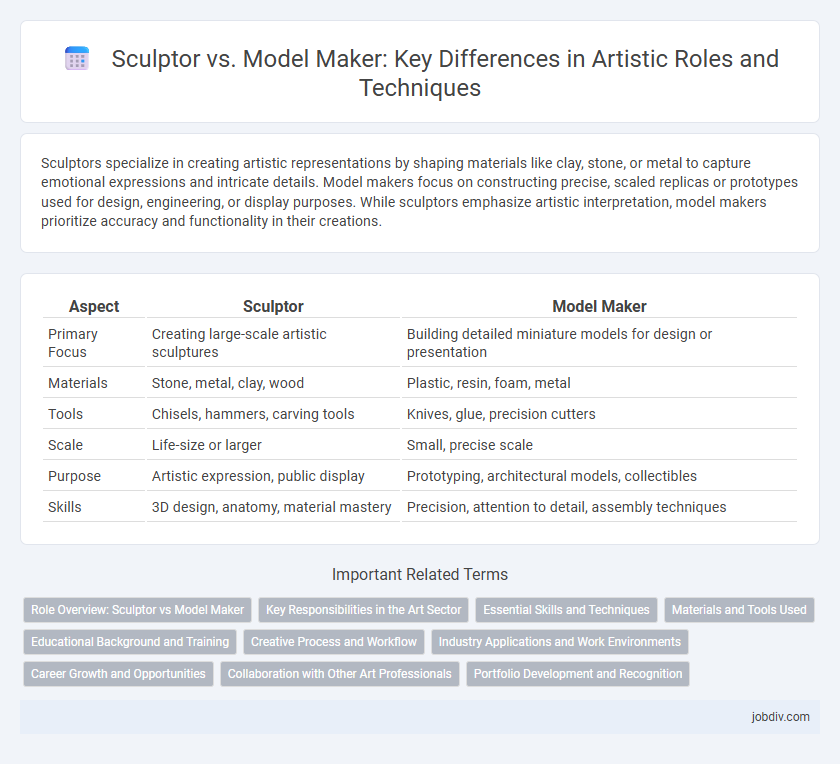Sculptors specialize in creating artistic representations by shaping materials like clay, stone, or metal to capture emotional expressions and intricate details. Model makers focus on constructing precise, scaled replicas or prototypes used for design, engineering, or display purposes. While sculptors emphasize artistic interpretation, model makers prioritize accuracy and functionality in their creations.
Table of Comparison
| Aspect | Sculptor | Model Maker |
|---|---|---|
| Primary Focus | Creating large-scale artistic sculptures | Building detailed miniature models for design or presentation |
| Materials | Stone, metal, clay, wood | Plastic, resin, foam, metal |
| Tools | Chisels, hammers, carving tools | Knives, glue, precision cutters |
| Scale | Life-size or larger | Small, precise scale |
| Purpose | Artistic expression, public display | Prototyping, architectural models, collectibles |
| Skills | 3D design, anatomy, material mastery | Precision, attention to detail, assembly techniques |
Role Overview: Sculptor vs Model Maker
Sculptors primarily create large-scale, expressive works of art by shaping materials such as clay, stone, or metal into three-dimensional forms, emphasizing artistic vision and emotional impact. Model makers focus on producing precise, scaled replicas or prototypes using materials like wood, plastic, or metal, often for architectural, industrial, or entertainment purposes. While sculptors prioritize creativity and aesthetics, model makers specialize in accuracy and functionality to serve design and planning needs.
Key Responsibilities in the Art Sector
Sculptors primarily focus on creating original three-dimensional art pieces, using materials such as clay, stone, metal, or wood to express artistic concepts and emotions. Model makers specialize in constructing precise scale models or prototypes, often assisting architects, designers, or animators by transforming technical drawings into tangible forms. Both roles demand a strong understanding of spatial relationships, material properties, and artistic vision, with sculptors emphasizing creative expression and model makers prioritizing accuracy and functionality.
Essential Skills and Techniques
Sculptors master techniques such as carving, modeling, and casting, requiring strong spatial awareness and an understanding of materials like clay, stone, or metal. Model makers excel in precision, attention to detail, and proficiency with tools for creating scale models, often utilizing CAD software and 3D printing technologies. Both roles demand a deep knowledge of form, texture, and anatomy to accurately translate artistic vision into physical objects.
Materials and Tools Used
Sculptors primarily work with materials such as marble, bronze, clay, and wood, utilizing tools like chisels, hammers, and welding equipment to shape and carve their creations. Model makers often use plastics, foam, and resin, employing precision tools including knives, saws, and 3D printers to craft detailed scale models. The choice of materials and tools directly influences the texture, durability, and intricacy of the finished artwork in both disciplines.
Educational Background and Training
Sculptors typically undergo formal education in fine arts programs, focusing on anatomy, materials, and creative design to develop their artistic skills. Model makers often receive specialized technical training in industrial design, engineering, or craftsmanship, emphasizing precision, scale, and prototype development. Both professions require hands-on experience, but sculptors lean toward conceptual creativity while model makers prioritize technical accuracy and replication.
Creative Process and Workflow
Sculptors emphasize freehand techniques and intuitive shaping, relying on materials like clay, stone, or metal to express form and emotion. Model makers prioritize precision and technical accuracy, often using CAD software and molds to create detailed prototypes or replicas. Both roles require a deep understanding of spatial relationships and material properties but differ in their balance between artistic freedom and meticulous reproduction.
Industry Applications and Work Environments
Sculptors often work in artistic studios or outdoor settings, creating large-scale, expressive art pieces used in galleries, public spaces, and cultural institutions. Model makers typically operate within industrial environments such as manufacturing companies, film studios, or architectural firms, producing precise prototypes and scale models for product development, visual effects, or architectural presentations. Both professions require mastery of materials and tools, but sculptors emphasize creativity and aesthetics while model makers prioritize technical accuracy and functionality.
Career Growth and Opportunities
Sculptors often experience career growth through exhibitions, gallery representation, and public art commissions, leveraging their creative vision and unique style to build a recognizable brand. Model makers, essential in industries like film, architecture, and product design, benefit from technical skill development and collaborations, allowing steady career advancement and specialization. Both roles offer diverse opportunities, but sculptors tend to gain broader public exposure, while model makers enjoy demand in commercial and applied arts sectors.
Collaboration with Other Art Professionals
Sculptors and model makers collaborate closely with architects, engineers, and designers to bring artistic visions into tangible forms with structural integrity and aesthetic precision. Sculptors contribute creative expertise and conceptual development, while model makers provide technical skills and detailed miniature representations critical for project approvals and client presentations. This synergy ensures the seamless integration of artistic intent and practical execution within complex art installations and public commissions.
Portfolio Development and Recognition
Sculptors build portfolios showcasing original, expressive works highlighting mastery of form, texture, and artistic vision, attracting galleries and collectors. Model makers develop detailed, accurate scale models for architects, filmmakers, and designers, emphasizing precision and technical skill over artistic interpretation. Recognition for sculptors often comes through exhibitions and art awards, while model makers gain credibility via industry projects and client endorsements.
Sculptor vs Model Maker Infographic

 jobdiv.com
jobdiv.com